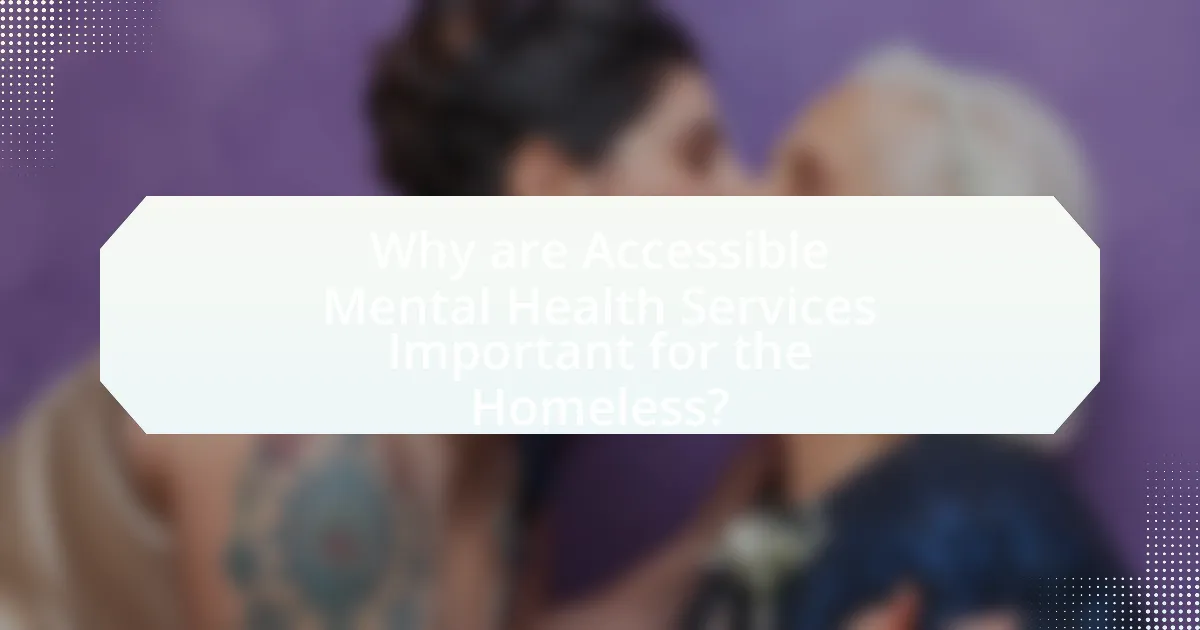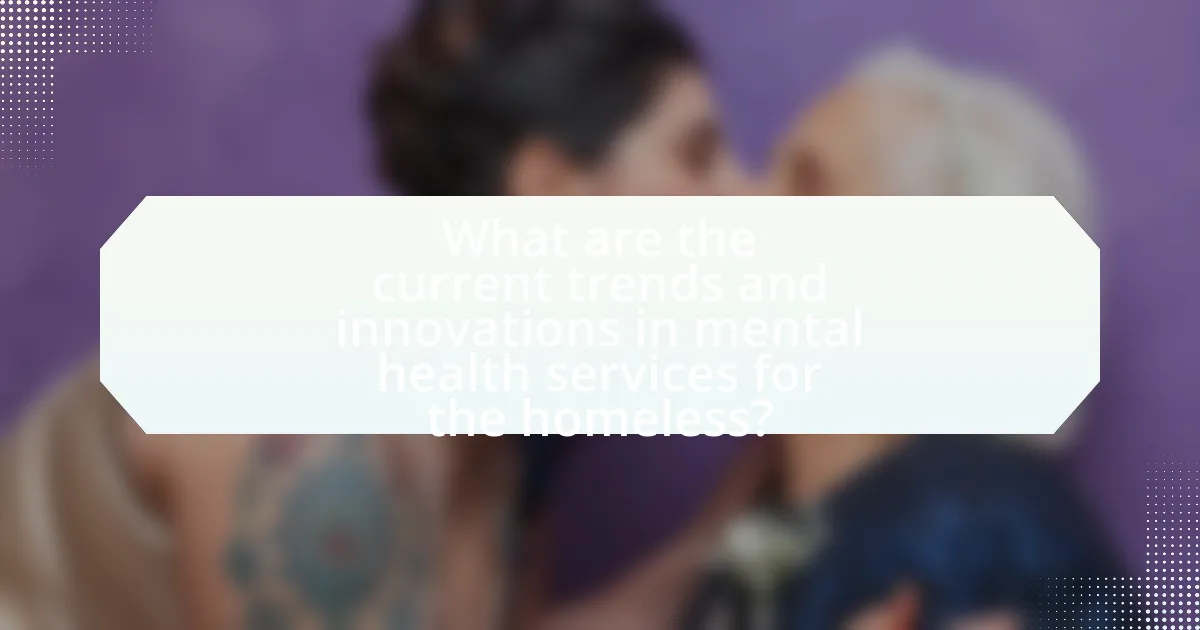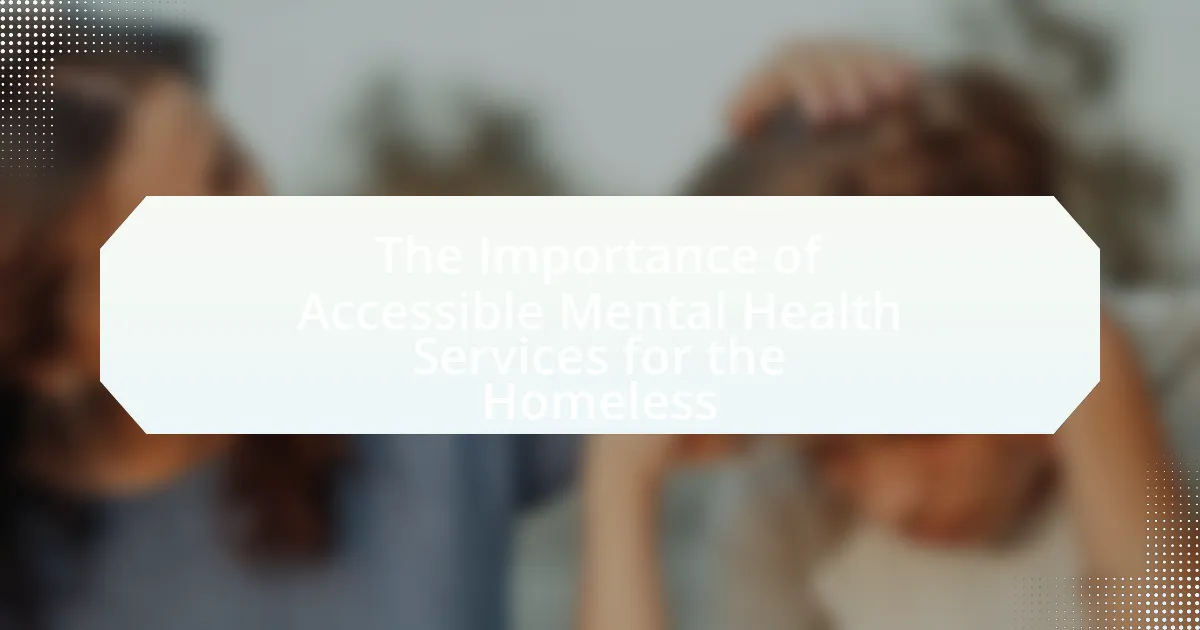Accessible mental health services are essential for the homeless population, as they address the high prevalence of mental health disorders, with approximately 30% of homeless individuals experiencing serious mental illness. The article examines the challenges faced by this group, including barriers to accessing care such as stigma, lack of transportation, and financial constraints. It highlights the benefits of accessible mental health services, including improved quality of life, reduced emergency room visits, and pathways to stable housing. Additionally, the article discusses effective service models, current trends in mental health care, and the role of community involvement and policy advocacy in enhancing service delivery for homeless individuals.

Why are Accessible Mental Health Services Important for the Homeless?
Accessible mental health services are crucial for the homeless because they address the high prevalence of mental health disorders within this population. Studies indicate that approximately 30% of homeless individuals experience serious mental illness, which exacerbates their vulnerability and hinders their ability to secure stable housing and employment. Accessible services provide essential support, enabling individuals to manage their conditions, improve their quality of life, and facilitate pathways to recovery and stability. Furthermore, research shows that when mental health services are readily available, there is a significant reduction in emergency room visits and hospitalizations, leading to better health outcomes and lower healthcare costs for communities.
What challenges do homeless individuals face regarding mental health?
Homeless individuals face significant challenges regarding mental health, primarily due to lack of access to services, stigma, and the impact of their living conditions. The absence of stable housing often exacerbates pre-existing mental health issues, leading to increased rates of anxiety, depression, and substance abuse. According to the National Alliance to End Homelessness, approximately 25% of the homeless population suffers from severe mental illness, which is significantly higher than the general population. Additionally, the stigma associated with homelessness and mental health can deter individuals from seeking help, further complicating their situation. The chaotic environment of homelessness, including exposure to violence and trauma, also contributes to deteriorating mental health, creating a cycle that is difficult to escape.
How does homelessness impact mental health conditions?
Homelessness significantly exacerbates mental health conditions by increasing stress, anxiety, and depression among individuals. The lack of stable housing creates an environment of uncertainty and fear, which can lead to the deterioration of existing mental health issues or the emergence of new ones. Research indicates that approximately 30% of homeless individuals experience serious mental illness, compared to 4% in the general population, highlighting the severe impact of homelessness on mental health. Additionally, the stigma associated with homelessness can further isolate individuals, making it difficult for them to seek help or access mental health services, thereby worsening their conditions.
What are the barriers to accessing mental health services for the homeless?
Barriers to accessing mental health services for the homeless include lack of transportation, financial constraints, and stigma. Transportation issues prevent individuals from reaching facilities, as many homeless individuals lack reliable means to travel. Financial constraints arise from the inability to afford services, as many mental health programs require payment or insurance that homeless individuals do not possess. Stigma surrounding mental illness further complicates access, as it can deter individuals from seeking help due to fear of judgment or discrimination. According to the National Coalition for the Homeless, these barriers significantly hinder the ability of homeless individuals to receive necessary mental health care.
How do accessible mental health services benefit the homeless population?
Accessible mental health services significantly benefit the homeless population by providing essential support for mental health issues, which are prevalent among this group. Studies indicate that approximately 30% of homeless individuals experience serious mental illness, making access to mental health care crucial for their well-being. These services help reduce symptoms of mental disorders, improve overall quality of life, and facilitate pathways to stable housing and employment. Furthermore, accessible mental health services can lead to decreased emergency room visits and lower healthcare costs, as individuals receive timely and appropriate care.
What improvements in well-being can be observed with access to mental health services?
Access to mental health services significantly improves well-being by reducing symptoms of mental illness, enhancing social functioning, and increasing overall life satisfaction. Studies indicate that individuals receiving mental health care experience a 50% reduction in symptoms of depression and anxiety, leading to better emotional stability and improved relationships. Furthermore, access to these services fosters a sense of community and support, which is crucial for homeless individuals who often face isolation. Research published in the Journal of Health Care for the Poor and Underserved highlights that homeless individuals with access to mental health services report higher levels of self-esteem and a greater ability to manage daily challenges, demonstrating the critical role these services play in enhancing their quality of life.
How do these services contribute to reducing homelessness?
Accessible mental health services contribute to reducing homelessness by addressing the underlying psychological issues that often lead to housing instability. These services provide essential support, such as therapy and medication management, which can stabilize individuals experiencing mental health crises. Research indicates that individuals with mental health conditions are at a higher risk of becoming homeless; for instance, the Substance Abuse and Mental Health Services Administration reports that approximately 20-25% of the homeless population in the U.S. suffers from severe mental illness. By offering targeted interventions, mental health services can help individuals regain stability, improve their quality of life, and ultimately secure and maintain housing.

What are the key components of effective mental health services for the homeless?
Effective mental health services for the homeless include accessibility, comprehensive care, and integration with social services. Accessibility ensures that services are available without barriers, such as cost or location, which is crucial given that approximately 30% of homeless individuals experience severe mental illness. Comprehensive care addresses both mental health and substance use disorders, recognizing the high comorbidity rates; studies show that around 50% of homeless individuals with mental health issues also struggle with substance abuse. Integration with social services, such as housing assistance and employment support, enhances the effectiveness of mental health interventions, as evidenced by programs that combine these services leading to improved outcomes in stability and recovery.
What types of mental health services are most beneficial for the homeless?
Assertive outreach services are the most beneficial mental health services for the homeless. These services provide direct support to individuals in their living environments, facilitating access to mental health care, substance abuse treatment, and social services. Research indicates that assertive outreach can significantly reduce psychiatric symptoms and improve overall well-being among homeless populations. For instance, a study published in the American Journal of Psychiatry found that individuals receiving assertive community treatment showed a 50% reduction in hospitalizations compared to those receiving standard care. This evidence underscores the effectiveness of tailored, accessible mental health services for homeless individuals.
How do outreach programs facilitate access to mental health care?
Outreach programs facilitate access to mental health care by actively engaging individuals in underserved communities, particularly the homeless, and connecting them with necessary services. These programs often employ trained professionals who conduct assessments, provide immediate support, and help navigate the healthcare system, thereby reducing barriers such as stigma, lack of transportation, and financial constraints. For instance, a study published in the American Journal of Psychiatry found that outreach initiatives significantly increased the likelihood of individuals receiving mental health treatment, demonstrating their effectiveness in bridging gaps in care.
What role do crisis intervention services play in supporting the homeless?
Crisis intervention services play a crucial role in supporting the homeless by providing immediate assistance during mental health crises, which can prevent further deterioration of their situation. These services offer essential support such as emergency counseling, stabilization, and connection to long-term mental health resources, addressing the acute needs of individuals experiencing homelessness. Research indicates that timely intervention can significantly reduce the risk of hospitalization and improve overall mental health outcomes, as evidenced by studies showing that individuals who receive crisis intervention are more likely to engage in ongoing treatment and achieve stability in their lives.
How can mental health services be made more accessible to the homeless?
Mental health services can be made more accessible to the homeless by integrating these services into existing shelters and community centers. This approach allows for immediate access to mental health care in environments where homeless individuals already seek support. Research indicates that co-locating mental health services with housing assistance programs significantly improves engagement and outcomes for homeless populations. For instance, a study published in the American Journal of Public Health found that individuals receiving integrated services experienced a 30% reduction in psychiatric symptoms compared to those who did not have access to on-site mental health care. Additionally, providing mobile mental health units can reach homeless individuals in various locations, further enhancing accessibility.
What strategies can be implemented to reduce stigma around mental health care?
To reduce stigma around mental health care, implementing educational programs that promote awareness and understanding of mental health issues is essential. These programs can be integrated into schools, workplaces, and community centers to foster a culture of acceptance and support. Research indicates that stigma can be significantly reduced through contact-based education, where individuals with lived experiences share their stories, leading to increased empathy and understanding among the public. For instance, a study published in the journal “Psychological Medicine” found that personal narratives effectively challenge stereotypes and misconceptions about mental illness, thereby decreasing stigma. Additionally, campaigns that normalize mental health discussions, such as “Mental Health Awareness Month,” can further contribute to changing societal perceptions and encouraging individuals to seek help without fear of judgment.
How can collaboration between organizations improve service delivery?
Collaboration between organizations can significantly improve service delivery by pooling resources, expertise, and information to create a more comprehensive support system. For instance, when mental health service providers collaborate with housing organizations, they can address both the psychological and physical needs of homeless individuals simultaneously, leading to better outcomes. Research indicates that integrated service models, which combine mental health care with housing support, can reduce homelessness by up to 30% and improve mental health outcomes, as evidenced by studies conducted by the National Alliance to End Homelessness. This collaborative approach ensures that services are not only accessible but also tailored to the unique needs of the homeless population, ultimately enhancing the effectiveness of service delivery.

What are the current trends and innovations in mental health services for the homeless?
Current trends and innovations in mental health services for the homeless include the integration of mobile health units, telehealth services, and trauma-informed care approaches. Mobile health units provide on-site mental health support, allowing professionals to reach homeless individuals directly in their communities, which has been shown to improve access to care. Telehealth services have expanded significantly, especially during the COVID-19 pandemic, enabling individuals to receive therapy and counseling remotely, thus overcoming barriers related to transportation and stigma. Additionally, trauma-informed care recognizes the impact of trauma on mental health and emphasizes creating a safe environment for individuals, which has been increasingly adopted in various service settings. These innovations are supported by studies indicating that such approaches lead to better engagement and outcomes for homeless populations, as evidenced by a report from the National Alliance to End Homelessness highlighting improved mental health outcomes through these methods.
How is technology being utilized to enhance mental health services for the homeless?
Technology is being utilized to enhance mental health services for the homeless through mobile applications, telehealth platforms, and data analytics. Mobile applications provide access to mental health resources, allowing individuals to connect with counselors and access self-help tools directly from their smartphones. Telehealth platforms facilitate remote consultations, enabling homeless individuals to receive therapy and psychiatric services without the need for transportation. Data analytics is used to identify trends and needs within homeless populations, allowing service providers to tailor interventions effectively. For instance, a study by the National Alliance to End Homelessness found that telehealth services increased access to mental health care by 30% among homeless individuals during the COVID-19 pandemic, demonstrating the effectiveness of technology in addressing mental health needs in this vulnerable population.
What are the benefits of telehealth services for homeless individuals?
Telehealth services provide significant benefits for homeless individuals by increasing access to healthcare, reducing barriers to treatment, and improving health outcomes. These services allow homeless individuals to receive medical and mental health care remotely, which is crucial given their often unstable living conditions and lack of transportation. Research indicates that telehealth can lead to higher engagement in care, with studies showing that individuals experiencing homelessness are more likely to attend appointments when they can do so via phone or video. Additionally, telehealth can facilitate timely interventions, which are essential for managing chronic conditions and mental health issues prevalent in this population.
How can mobile mental health units improve access to care?
Mobile mental health units can improve access to care by delivering services directly to underserved populations, such as the homeless. These units eliminate barriers like transportation and stigma, allowing individuals to receive immediate mental health support in familiar environments. Research indicates that mobile units can increase engagement in care; for instance, a study published in the Journal of Community Psychology found that mobile outreach led to a 50% increase in service utilization among homeless individuals. By providing on-site assessments, therapy, and medication management, mobile mental health units effectively address the unique challenges faced by this vulnerable population.
What policies are needed to support accessible mental health services for the homeless?
To support accessible mental health services for the homeless, policies must include increased funding for mental health programs, integration of services within homeless shelters, and the establishment of mobile mental health units. Increased funding is essential, as studies show that adequate financial resources lead to improved service availability and quality, directly impacting the mental health outcomes of homeless individuals. Integration of services within shelters ensures that mental health support is readily available in environments where homeless individuals seek refuge, facilitating immediate access to care. Mobile mental health units can reach homeless populations in various locations, providing essential services directly to those in need, which is crucial given that many homeless individuals face barriers to accessing traditional healthcare facilities.
How can government initiatives improve funding for mental health services?
Government initiatives can improve funding for mental health services by allocating specific budgetary resources and creating targeted programs that address mental health needs. For instance, the Substance Abuse and Mental Health Services Administration (SAMHSA) reported that federal funding for mental health services increased by 30% from 2015 to 2020, which directly supported the expansion of community-based mental health programs. Additionally, initiatives like the Mental Health Parity and Addiction Equity Act mandate that mental health services be covered equally to physical health services, thereby increasing funding through insurance reimbursements. These measures ensure that mental health services are more accessible, particularly for vulnerable populations such as the homeless, who often face significant barriers to care.
What role do non-profit organizations play in advocating for policy changes?
Non-profit organizations play a crucial role in advocating for policy changes by representing marginalized communities and influencing legislative agendas. They mobilize resources, conduct research, and raise public awareness about issues, such as mental health services for the homeless, which often lack adequate funding and support. For instance, organizations like the National Alliance on Mental Illness (NAMI) have successfully lobbied for policies that improve access to mental health care, demonstrating the effectiveness of advocacy efforts in shaping public policy. Their ability to connect personal stories with data-driven arguments helps to humanize issues and persuade policymakers to take action.
What practical steps can be taken to improve mental health services for the homeless?
To improve mental health services for the homeless, implementing integrated service models that combine mental health care with housing support is essential. Research indicates that programs like Housing First, which provide stable housing without preconditions, significantly enhance mental health outcomes for homeless individuals. A study published in the American Journal of Psychiatry found that participants in Housing First programs experienced reduced psychiatric symptoms and improved quality of life. Additionally, increasing funding for mobile mental health units can ensure that services reach homeless populations directly, addressing barriers such as transportation and stigma. Collaborating with local organizations to provide training for staff on trauma-informed care can further enhance the effectiveness of these services.
How can community involvement enhance the effectiveness of mental health programs?
Community involvement can enhance the effectiveness of mental health programs by fostering trust and engagement among participants. When community members actively participate in the design and implementation of mental health initiatives, they can tailor services to meet the specific needs of the population, particularly the homeless. Research indicates that programs with strong community ties report higher rates of participation and satisfaction, as seen in the study “Community-Based Mental Health Services for Homeless Individuals” published in the American Journal of Psychiatry, which found that localized support networks significantly improved treatment adherence and outcomes. This collaborative approach not only increases accessibility but also reduces stigma, making individuals more likely to seek help.
What best practices should be followed to ensure service accessibility?
To ensure service accessibility, organizations should implement user-centered design principles, which focus on understanding and addressing the specific needs of diverse populations. This includes providing services in multiple languages, ensuring physical accessibility for individuals with disabilities, and offering flexible hours to accommodate varying schedules. Research indicates that 25% of homeless individuals experience mental health issues, highlighting the necessity for tailored services that meet their unique circumstances. Additionally, integrating technology, such as telehealth options, can enhance access for those unable to attend in-person appointments, further supporting the need for adaptable service delivery methods.

Leave a Reply